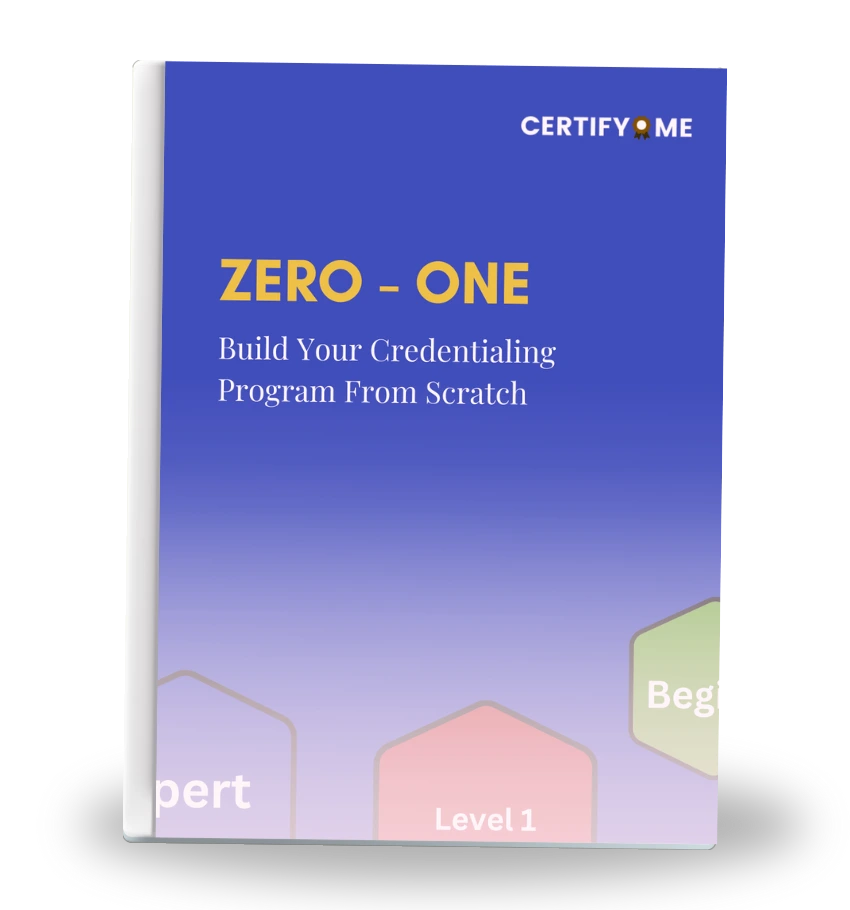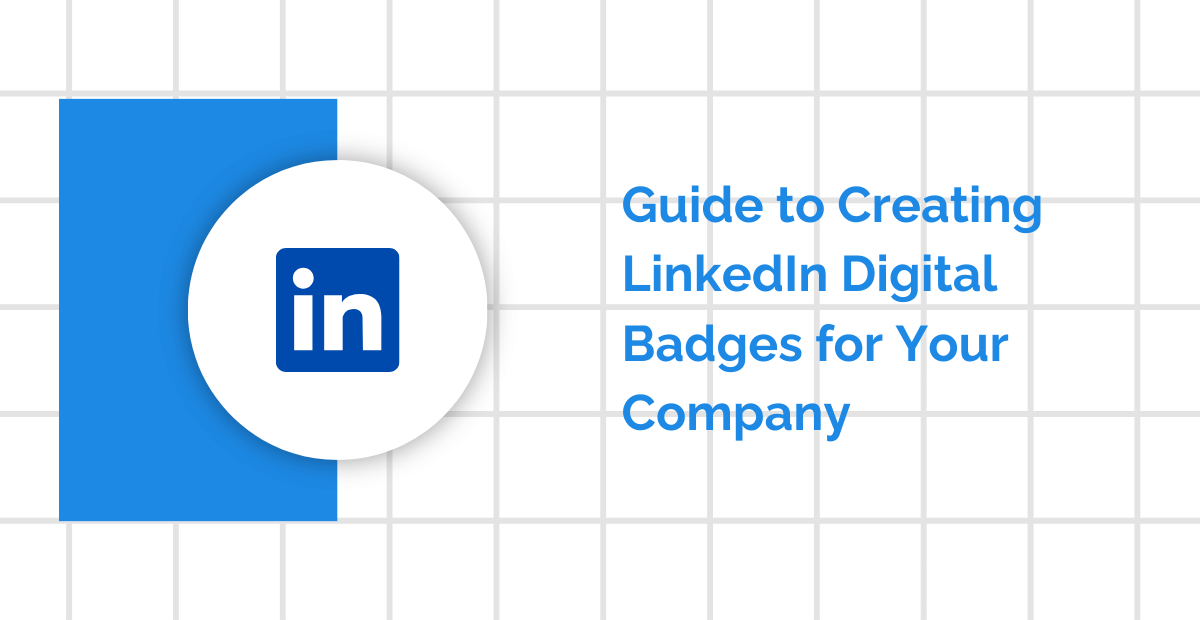You know that moment when a job application, grad school form, or even an immigration process asks for your “official academic transcript,” and you’re just sitting there, blinking at the screen, thinking.
What exactly are they asking for? You’re not alone. Every year, thousands of students and even university staff stumble over the same question: What is an academic transcript, and how do I get mine?
This blog is your simple, jargon-free guide. We’ll break it down, section by section, just like a helpful senior would over coffee. Ready?
What Is an Academic Transcript, Really?
Imagine your academic transcript as your educational fingerprint. It’s a formal document that details your academic journey at a particular institution. If college were a story, this would be the table of contents—showing what courses you took, how you performed, and the credit hours you earned.
Here’s what a typical academic transcript includes:
-
Your full name and student ID number
-
Names of the institutions attended
-
List of courses taken (with course codes and titles)
-
Grades earned in each course
-
GPA (Grade Point Average)
-
Degree(s) conferred and date(s) awarded
-
Academic honors (like Dean’s List)
But there are two kinds of transcripts you’ll hear about:
-
Unofficial Transcript: A downloadable or printable record, usually accessible via your student portal. It shows all your grades but isn’t signed or sealed.
-
Official Transcript: Authenticated by the Registrar’s office, sealed or digitally encrypted, and sent directly to the intended recipient.
Think of it this way: the unofficial version is like a selfie you took at home; the official version is like a passport photo validated by a government agency.
So why do people need academic transcripts?
-
Job Applications: Employers want to verify your academic record.
-
Graduate School: Admission officers review transcripts to assess eligibility.
-
Transfers: New universities need your course history.
-
Visa Processing: Immigration services may request transcripts.
As we move deeper into 2025, transcripts are becoming more than just paper documents. They are turning into smart, sharable, digital records that can travel faster than you do. But more on that later.
Still, the core idea remains: a transcript is proof of your academic life. And whether you’re a student trying to land your first job or a registrar processing hundreds of requests, understanding what this document includes is the first step.
The Different Flavors of Transcripts
Let’s break it down into something relatable: Think of academic transcripts like different kinds of pizza. The base is always the same (your academic history), but the presentation can vary based on how and where you want to serve it.
-
Unofficial Transcript
-
Easy to access.
-
Downloadable from your student portal.
-
Good for personal reference or sharing with family.
-
Not accepted for official use.
Most students use unofficial transcripts to double-check their grades, apply for scholarships, or plan their course loads. It’s like a working draft of your educational story.
-
-
Official Transcript
-
Authenticated by the university.
-
Usually includes the registrar’s signature and institutional seal.
-
Often sent directly to employers, universities, or government offices.
-
Typically not opened by the student if it’s paper-based.
This is the real deal. It’s the version you send when the stakes are high.
-
-
Digital Transcript in 2025
This is where it gets interesting. In 2025, more universities are ditching envelopes and moving towards digital formats. Think secure PDFs, blockchain-based credentials, and digital lockers.
Why the shift?
-
Faster delivery: Minutes instead of days.
-
Tamper-proof: Encrypted and authenticated.
-
Eco-friendly: No paper, no ink.
-
Still confused? Let’s simplify.
-
Need it for your own use? Go unofficial.
-
Need it for an application or employer? Go official.
-
Need it quick and secure in 2025? Go digital.
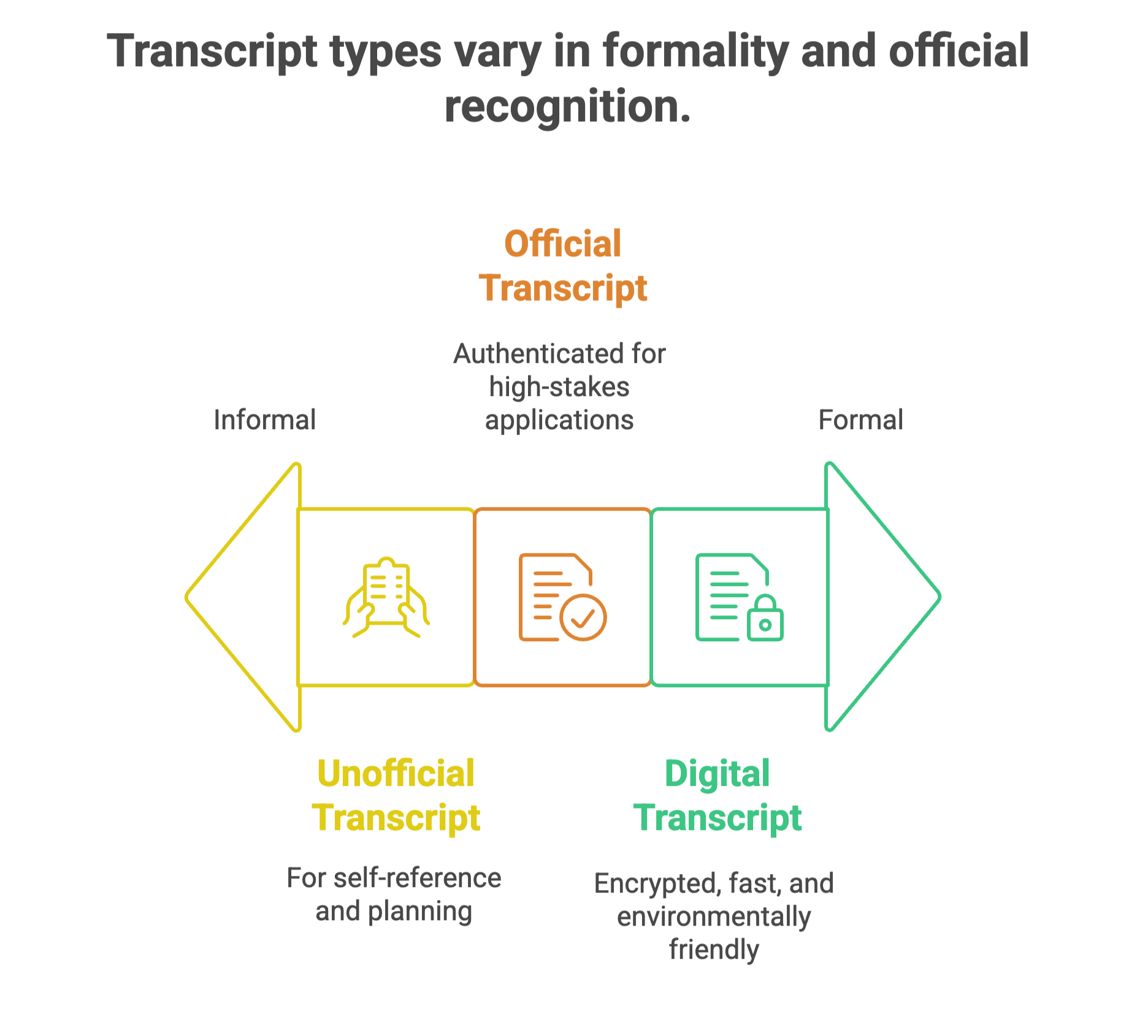
And yes, students can often request both versions from their student portal, but be sure to check what the recipient requires. Some graduate schools still prefer a sealed envelope, while some companies may ask for a secure digital link.
Ultimately, knowing which “flavor” of transcript to request depends on what you’re using it for. Ask yourself, “Who needs it? Why do they need it? And how do they want it delivered?”
How to Get Your Academic Transcript in 2025
Getting your transcript in 2025 is much easier than it was a decade ago. Many institutions have made the entire process online, smooth, and fast. But if you’re new to this or need a refresher, here’s a step-by-step guide.
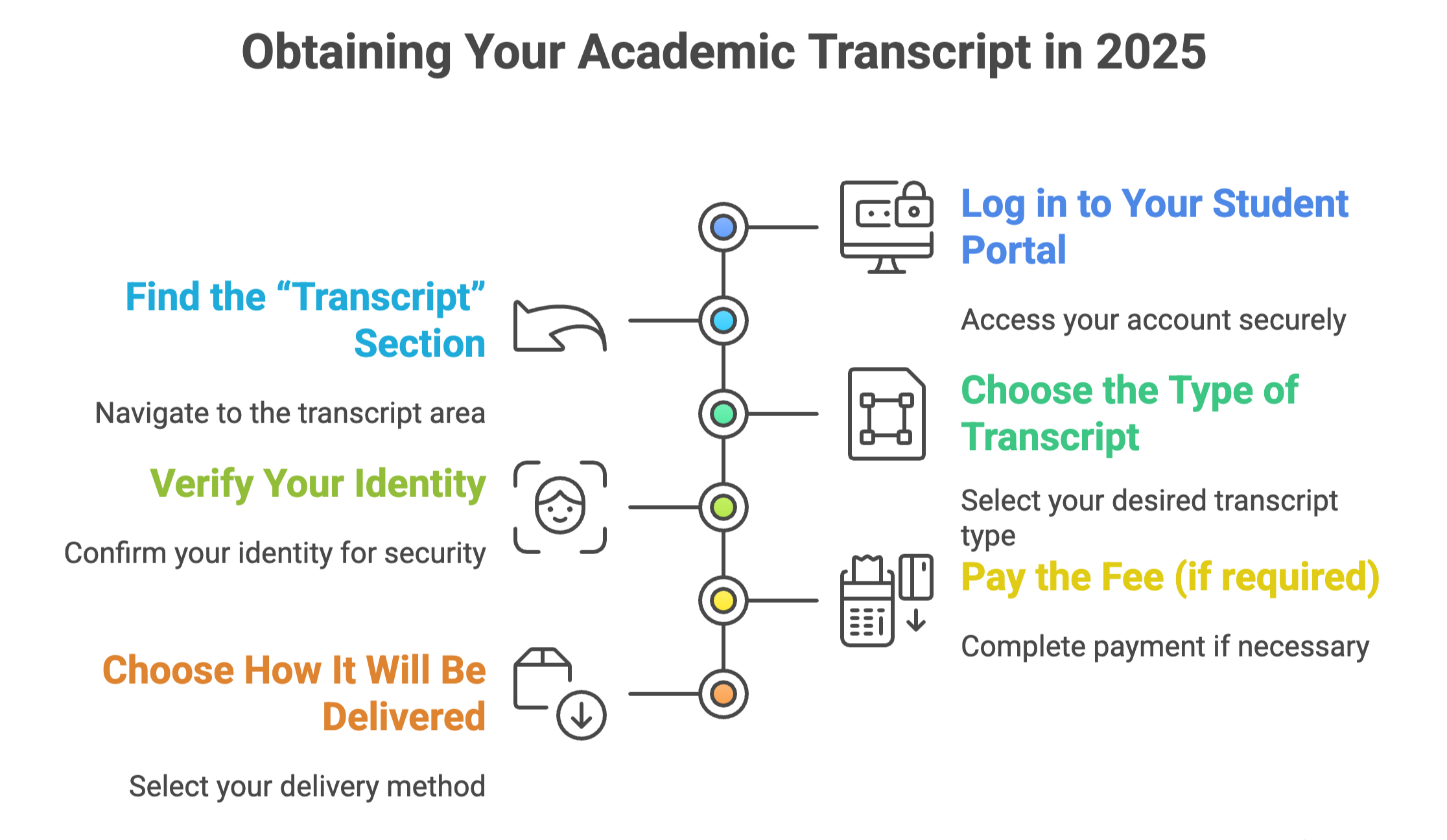
Step 1: Log in to Your Student Portal
This might be your university’s internal system like Banner, PeopleSoft, or a custom-built portal. You’ll need your student credentials.
Step 2: Find the “Transcript” Section
Usually under “Student Records” or “Academic Records.”
Step 3: Choose the Type of Transcript
-
Want a PDF copy to keep? Go unofficial.
-
Need one for an employer? Choose the official transcript.
-
Going digital? Pick the encrypted delivery option.
Step 4: Verify Your Identity
You may be asked for additional verification (like OTPs or email confirmation).
Step 5: Pay the Fee (if required)
Some universities charge $5–10 for official transcripts. Others offer a few free requests per semester.
Step 6: Choose How It Will Be Delivered
-
Email to recipient
-
Downloadable secure link
-
Mailed paper copy (yes, still an option!)
Pro Tips:
-
Double-check the recipient’s address or email.
-
If applying to grad school, confirm their preferred delivery format.
-
Save a copy for yourself (where allowed).
How Long Does It Take?
-
Digital: Sometimes instant. Usually within 24 hours.
-
Mail: 5–10 business days, depending on location.
-
In-Person Pickup: Some universities allow this with prior appointment.
Common Mistakes to Avoid:
-
Misspelling recipient emails.
-
Choosing the wrong type (unofficial when official was needed).
-
Requesting during peak times like end-of-semester.
Still stuck? Call or email your Registrar’s office. They’re there to help—and trust us, they’ve seen every kind of transcript mishap.
For Registrar’s Office Staff: What Students Expect in 2025
If you’re part of a Registrar’s office, you’ve probably noticed that students are expecting faster, more intuitive services. And when it comes to transcripts, the shift toward digital-first isn’t a trend—it’s the new standard.
What Students Want Today:
-
Speed: Instant or same-day transcript processing.
-
Transparency: Real-time status tracking.
-
Ease of Use: Mobile-accessible platforms with minimal steps.
-
Support: Chatbots, FAQs, and email responses within 24 hours.
Challenges on Your Side:
-
High volume of requests during peak periods.
-
Data privacy concerns (hello, FERPA).
-
Platform limitations or outdated systems.
Digital Tools to Consider:
-
EduTranscript: Allows students to receive verified credentials via digital wallets.
-
Parchment & National Student Clearinghouse: Widely used third-party solutions that ensure security and automation.
The Tech Landscape in 2025:
-
Institutions are adopting blockchain for secure, tamper-proof transcripts.
-
AI is being used to auto-process standard requests.
-
Student identity verification is often done using multi-factor authentication.
Privacy Reminder:
Remember FERPA (Family Educational Rights and Privacy Act). Always ensure:
-
Transcripts are shared only with student consent.
-
Secure protocols are used for both storage and delivery.
Registrar offices today are no longer just administrative hubs. They are customer service centers that bridge legacy systems and future-ready student expectations. Making transcript access smoother isn’t just a tech upgrade—it’s a trust-building move.
Common Questions Students Ask (and Their Answers)
Here are some of the most frequently asked questions students ask about academic transcripts. If you’re one of them, you’re in good company.
-
Is my transcript free?
Usually, unofficial transcripts are free. Official ones may have a small fee ($5–$15), especially for mailed copies.
-
How long does it take to get one?
-
Digital: Sometimes instant
-
Mailed: 3–10 business days
-
In-person: Same day (if allowed)
-
-
Can I email my transcript to an employer?
You can, but it’s better if your university sends it directly to ensure authenticity.
-
What if I studied abroad?
You’ll need to request transcripts from that institution separately. Some universities include exchange credits, but not always.
-
Will my GPA be on the transcript?
Yes, most official transcripts include cumulative GPA.
-
What happens if there’s a mistake?
Contact your Registrar immediately. Errors in course names, grades, or graduation status should be corrected before sending your transcript anywhere.
-
Can I request transcripts if I have pending fees?
Some universities block transcript access until all dues are cleared. Check your student account.
-
Do employers really look at transcripts?
For internships, graduate roles, and early-career jobs—yes. Especially in competitive fields.
This section can be a lifesaver for students, especially during graduation season or application deadlines. Share it, bookmark it, and maybe even stick it on your dorm fridge.
How Technology Is Changing Transcripts (But Don’t Worry!)
Let’s face it: the word “blockchain” can feel intimidating. But when it comes to transcripts, the tech upgrades in 2025 aren’t just buzzwords—they’re making life easier for everyone involved.
So, what’s different today?
-
Digital Wallets: Students can now receive and share transcripts from secure mobile apps.
-
Blockchain Credentials: These are tamper-proof, instantly verifiable documents stored on secure networks.
-
Credential Ecosystems: Universities partner with platforms like EduTranscript to automate transcript issuing.
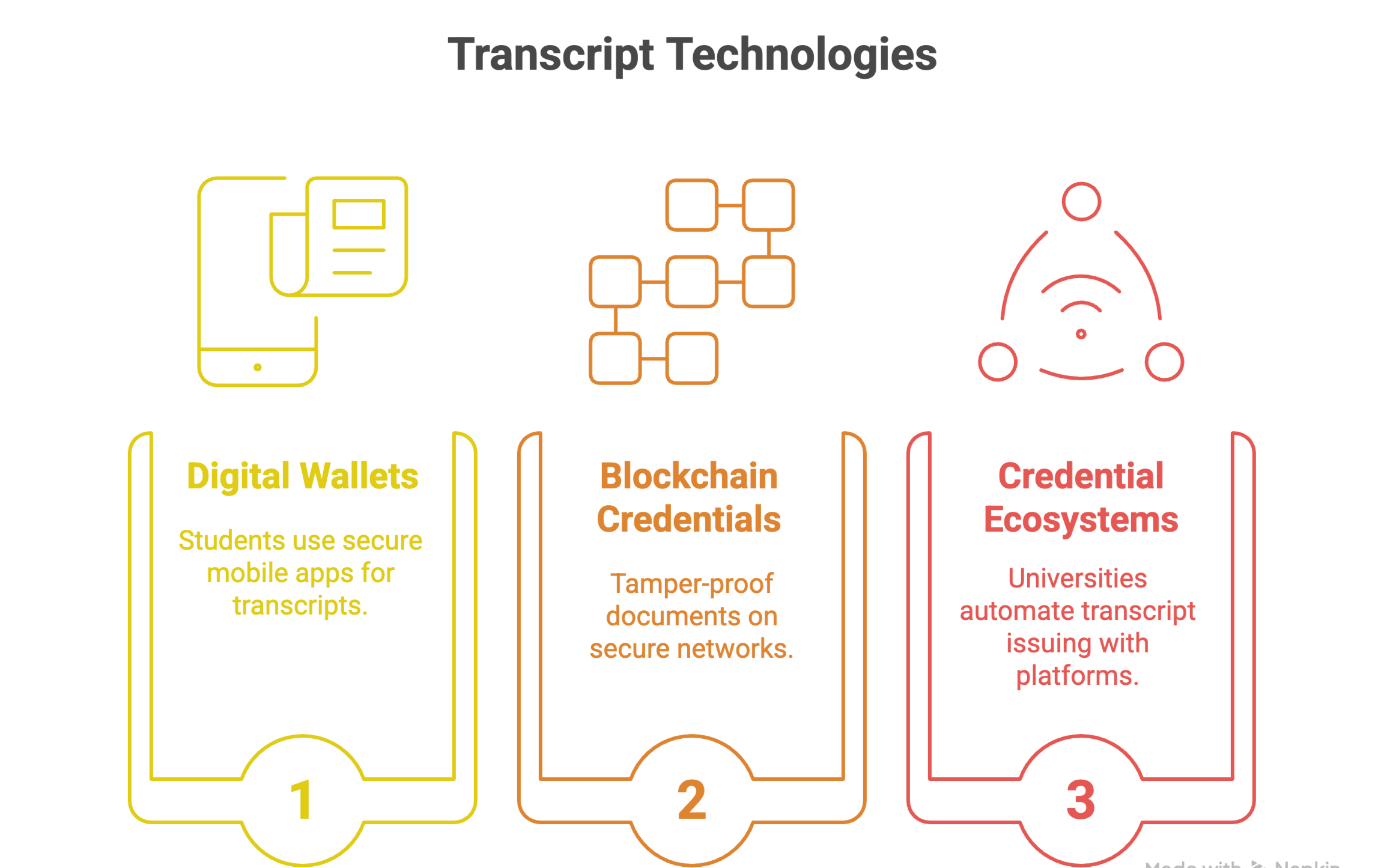
How it helps students:
-
No more long waits or physical pickups
-
Instant sharing with employers or schools
-
Verification in seconds
How it helps universities:
-
Reduced admin burden
-
Improved record-keeping accuracy
-
Enhanced trust and credibility
Still skeptical? Think of it like this: instead of waiting for the mail, you now get a certified document in your inbox that you can share with a click—and it can’t be faked.
Digital transcripts are not about replacing university systems. They’re about enhancing them. And for students and staff alike, it means fewer delays, fewer errors, and more control.
Conclusion: A Gentle Nudge to Take Action
Let’s rewind a bit. Whether you’re a student gearing up for an internship, applying to grad school, or a registrar navigating dozens of transcript requests each day—your academic transcript is more than just a document. It’s your story. It reflects years of work, dedication, and growth. And in 2025, it deserves to be accurate, accessible, and effortlessly shareable.
The good news? The tools are catching up. With digital platforms like CertifyMe, both students and university staff can manage, issue, and verify academic transcripts in just a few clicks. No more chasing envelopes or waiting weeks for processing. Just smart, secure, and student-friendly credentials.
If you’re a student, take a moment—log into your portal, check your transcript, and make sure everything is in place. That future opportunity won’t wait forever.
If you’re part of a registrar’s office, now’s the time to rethink how credentials are handled. Outdated systems slow everyone down.
Digital solutions like CertifyMe make it easier to issue trusted records, reduce manual workloads, and support learners more effectively.
Your transcript might be a single file or a secure digital badge—but what does it represent? Years of hard-earned achievement. Make sure it’s ready to go when it matters most.
Book a demo with CertifyMe and see how effortless academic credentialing can be.
.png)
 Author :
Author : 

